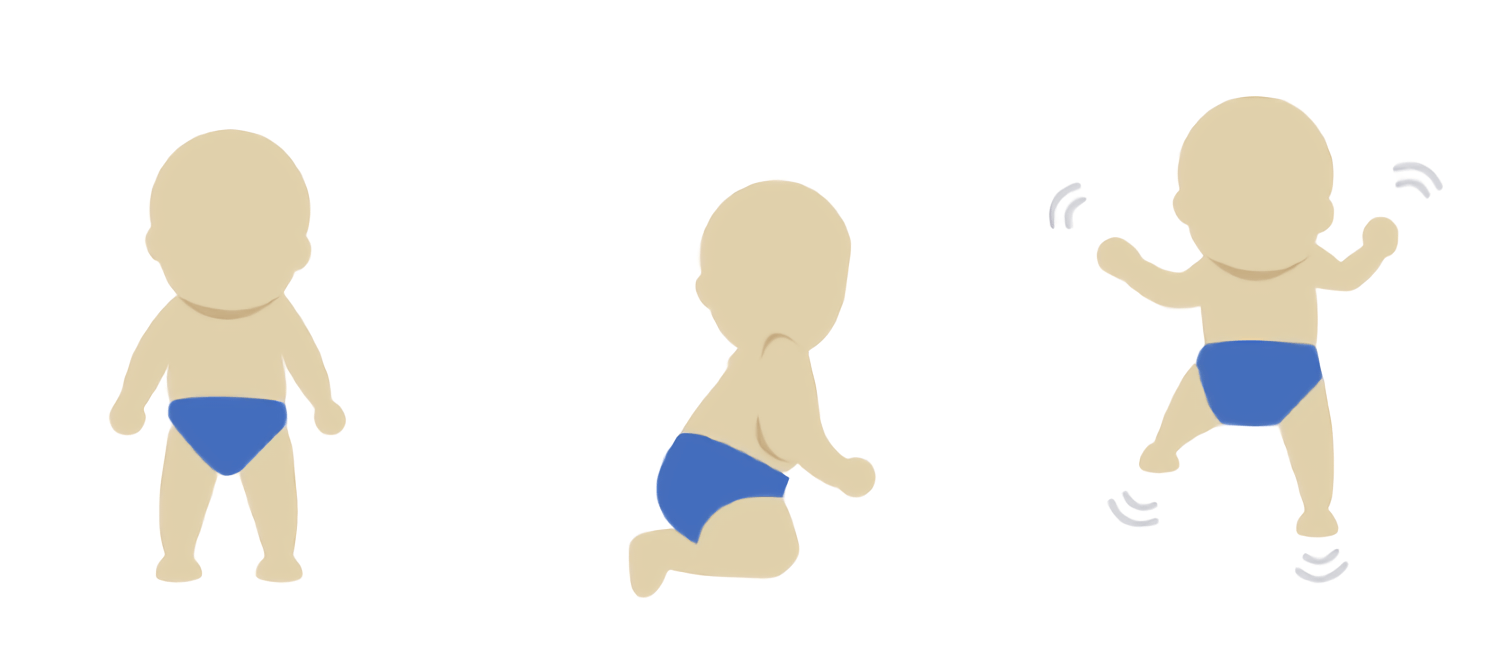The characters shown are real patients and the required consent to use their stories has been obtained from the patients and families. Photographs are for illustrative purposes only.
SCALES TO HELP QUANTIFY SMA
Several motor function scales have been developed that are useful in quantifying the natural history of spinal muscular atrophy (SMA), as well as the response to investigational therapeutic agents in clinical trials.2-4
MEASURING THE PROGRESSION OF SMA
The natural progression of SMA involves loss of motor function. Following an initial increase, a peak in motor skills and subsequent downturn marks the onset of SMA, with disease progression (and loss of motor skills) being most rapid in the early stage.1
The Children’s Hospital of Philadelphia Infant
Test of Neuromuscular Disorders (CHOP INTEND)
This test is used to evaluate the motor skills of infants with SMA:2,5
Includes 16 items used to assess motor skills and usually used for patients with very limited motor skills (e.g. not able to sit, poor head control)
Each item is graded on a scale of 0-4, where 0 represents no response to a particular test, and 4 represents a complete response
Total score ranges from 0 to 64 and declines by ~1.3 points per year on average6
This test is also used to assess SMA Type I patients:2
For those with very limited motor skills (e.g. not able to sit, poor head control)
Total score ranges from 0 to 64 and declines by ~1.3 points per year on average6
| CHOP INTEND: | |||
|---|---|---|---|
| 1 | Spontaneous movement (upper extremity) | 9 | Shoulder flexion & elbow flexion |
| 2 | Spontaneous movement (lower extremity) | 10 | Knee extension |
| 3 | Hand grip | 11 | Hip flexion and foot dorsiflexion |
| 4 | Head in midline with visual stimulation | 12 | Head control |
| 5 | Hip adductors | 13 | Elbow flexion |
| 6 | Rolling: elicited from legs | 14 | Neck flexion |
| 7 | Rolling: elicited from arms | 15 | Head / neck extension |
| 8 | Shoulder and elbow flexion and horizontal abduction | 16 | Spinal incurvation |
Hammersmith Infant Neurological Examination (HINE)
HINE is a simple motor function assessment tool designed to evaluate motor skills in infants from 2 months to 2 years of age:7
Exam includes 26 items that provide a comprehensive assessment of an infant’s neuromuscular development7
Each item is scored from 0 to 3, with a total possible score of 787
Mercuri et al, Neuromuscular Disorder, 2018
Finkel et al, Neuromuscular Disorder, 2018
Hammersmith Functional Motor Scale—Expanded (HFMSE)
HFMSE is a validated measure that has been used in several clinical trials to evaluate the motor function of children with spinal muscular atrophy.
This exam adds 13 clinically relevant items from the Gross Motor Function Measure (GMFM) related to lying / rolling, crawling, crawling / kneeling, standing, and walking / running / jumping:4,9
Exam has 33 items that are scored on a scale of 0 to 2
Total score ranges from 0 to 66, with lower scores indicating poorer motor function
Electrophysiologic measurements
In SMA, electrophysiologic measurements may be used to assess the health of motor neurons10
Compound muscle action potential (CMAP) response is a measure of the electrophysiologic output from a specific muscle or muscle group following stimulation of a peripheral nerve11
Motor unit number estimation (MUNE) is a method that estimates the number of motor units supplying a specific muscle12
MUNE values are calculated from the ratio of the maximal CMAP to the average single motor neuron potential (SMUP)12
SMUP is measured by moving a stimulating electrode along a motor nerve at multiple points12
Early diagnosis may be an important consideration in the treatment of spinal muscular atrophy. The pattern of motor neuron loss seen in SMA suggests that a treatment for infantile-onset (Type I) SMA should be administered as early as possible, including the presymptomatic period before significant loss of motor neurons.13
Find out more about the different types of SMA.
STAY UP TO DATE
Learn more about Biogen's participation to major events within Neurology.
The characters shown are real patients and the required consent to use their stories has been obtained from the patients and families. Photographs are for illustrative purposes only.
References
1. Swoboda KJ, et al. Perspectives on clinical Trials in Spinal Muscular Atrophy. J Child Neurol 2007;22(8):957-966.
2. Glanzman AM, et al. The Children’s Hospital of Philadelphia Infant Test of Neuromuscular Disorders (CHOP INTEND): test development and reliability. Neuromuscul Disord 2010;20(3):155-161.
3. De Sanctis R., et al. Developmental milestones in type I spinal muscular atrophy, Neuromuscular Disorders. Volume 26, Issue 11, 2016, 754-759.
4. Mercuri E, et al. Patterns of disease progression in type 2 and 3 SMA: implications for clinical trials. Neuromuscul Disord 2016;26(2):126-131.
5. Spinal Muscular Atrophy Clinical Research Center. CHOP INTEND for SMA Type I score sheet. [online] Mar 2013 [cited 2020 Sep 30]. Available from: URL: http://columbiasma.org/docs/cme-2010/CHOP%20INTEND%20for%20SMA%20Type%20I%20-%20Score%20Sheet.pdf.
6. Finkel RS, et al. Observational study of spinal muscular atrophy type I and implications for clinical trials. Neurology 2014;83:810-817.
7. Romeo DM, Ricci D, Brogna C, Mercuri E. Use of the Hammersmith Infant Neurological Examination in infants with cerebral palsy: a critical review of the literature. Dev Med Child Neurol 2016;58(3):240-245.
8. British Paediatric Neurology Association. Hammersmith Infant Neurological Examination. [online] Juli 2017 [cited 2021 Jan 29]. Available from: URL: https://bpna.org.uk/userfiles/HINE%20proforma_07_07_17.pdf.
9. The Pediatric Neuromuscular Clinical Research Network for SMA. Expanded Hammersmith Functional Motor Scale for SMA (HFMSE). [online] Mar 2009 [cited 2016 Apr 25]. Available from: URL: http://columbiasma.org/docs/cme-2010/Hammersmith%20Functional%20Motor%20Scale%20Expanded%20for%20SMA%20Type%20II%20and%20III%20-%20Manual%20of%20Procedures.pdf.
10. Swoboda KJ, et al. Natural history of denervation in SMA: relation to age, SMN2 copy number, and function. Ann Neurol 2005;57(5):704-712.
11. Arnold WD, et al. Electrophysiological motor unit number estimation (MUNE) measuring compound muscle action potential (CMAP) in mouse hindlimb muscles. J Vis Exp 2015;103:1-8.
12. Bromberg MB, Swoboda KJ. Motor unit number estimation in infants and children with spinal muscular atrophy. Muscle Nerve 2002;25(3):445-447.
13. Finkel RS. Electrophysiological and motor function scale association in a pre-symptomatic infant with spinal muscular atrophy type I. Neuromuscul Disord. 2013;23(2):112-115.



























